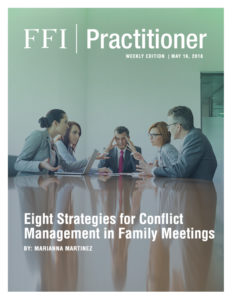
View this edition in our enhanced digital edition format with supporting visual insight and information.
Thanks to Marianna Martinez, a member of the FFI IberoAmercian Virtual Study Group, for this article entitled, “Eight Strategies for Conflict Management in Family Meetings.” You have your choice of reading it in English or in Spanish! More articles from this group will be forthcoming. We appreciate their taking the lead in helping us publish in two languages!
Family meetings present a challenge for consultants of family businesses. During these meetings, in addition to having a specific task in their specialized area (legal, financial, philanthropic, organizational, etc.), they need to manage the conflict that frequently arises when important topics for the family are addressed. Conflict is defined as opposition or disagreement (1). It arises when individuals faced with a difference of opinion try to change the feelings, thoughts, or behavior of others. Conflict also arises when one person needs something from another person, and, if he or she does not get it, tries to make the other person acquiesce to the demand, sometimes by force.
All families have moments or times in which they experience tension, depending on the pressure to which they are subjected. A relaxed family is a very different organism to a tense family. When stress is high, people’s capacity for thinking clearly, deliberately, and flexibly is diminished, and conflicts are more frequent. A relaxed family is less vulnerable to conflicts and its members are more capable of making better decisions (2)(3). When conflict arises, the consultant is required to know how to manage emotional processes during family meetings, such that the family may regain a state conducive to reflection. The consultant needs to ensure that the conflict does not become an obstacle to achieving the objectives of the meeting. Differences of opinion, opposing points of view, and even heated discussions are not the problem. The problem is when emotions that arise during conflict obstruct the capacity to find solutions.
The following are some strategies that can be helpful to reduce tension during family meetings:
1. Modulate emotional reactivity. Human beings are very sensitive to the signals that we perceive from others, especially from our own family. A look, bodily posture, physical proximity, or tone of voice is often interpreted as a threat and thus generates an immediate emotional reaction (4) leading to conflict. To modulate reactivity, the consultant may request that each participant address him or her directly, minimizing the interaction among family members. After listening to one of the members of the family and asking questions to elicit his or her opinion, the consultant then moves to another member of the family and does the same, generating a dialogue one-by-one between the consultant and the family. After listening to various members of the family, the consultant asks others what they were thinking while they were listening to the first person (5). This structure allows the person addressing the consultant directly to speak in the most articulate manner possible; and at the same time, it allows listeners to do so, without worrying about providing an immediate response, allowing them to ponder further what is being said.
2. Change the focus of attention. When a topic generates too much tension, characteristics of reactivity begin to manifest, such as searching for people to blame, raising voices, disinterest in conversation, or “tunnel vision.” When this point is reached, it is recommended to change the focus of attention for a few minutes. This can be done by asking questions about aspects related to the topic, but with less of an emotional charge (6). This technique allows people to regulate anxiety levels and return to the matter at hand with greater calm.
3. Maintain a broad vision of the problem. When emotions dominate the state of mind, complex realities tend to be simplified. Simplification is a mechanism that helps in rapid decision making, especially in dangerous situations (real or imagined), but this strategy does not allow for consideration of various factors simultaneously (7). The consultant, by asking broad questions, invites family members to take a wider perspective, allowing them to consider multiple aspects of the problem under discussion. Questions such as: “How did the problem arise and in what context? Who is involved in the matter? What is the impact of one decision versus another on other persons or groups?” These questions stimulate family members to concentrate on understanding the issue to be resolved with greater clarity and to remove themselves from the friction of the moment.
4. Concentrate on the facts. When people’s perception of reality is altered, they become more subjective and, as such, more conducive to generating conflicts. If the consultant can concentrate on the facts more than on interpretations of the facts — for example, intentions, motivations, and suppositions — the objectivity required to discuss delicate topics is facilitated (8).
5. Recognize emotions, but do not concentrate on them. Emotions are a good source of information regarding what is happening in the mind of a person and in his or her relationships. On one hand, ignoring them only generates greater irritation, but on the other hand, concentrating on emotions tends to exacerbate them. Identifying the emotions in the family and giving space to everyone to express them is important. Likewise, it is important to ensure that the person does not get lost in his or her emotional world but maintains active intellectual functions (9). For example, the consultant might say, “I see that this has been difficult for you, not feeling appreciated for the work that you have done for the business. When did you begin to feel this way?” or “You feel angry because you feel that what has happened is unfair. Who else in the family feels angry?” These types of questions recognize and validate the person’s experience while pushing to continue a productive conversation of exploration.
6. Show interest in the situation and in the family. A genuine attitude of curiosity on the part of the consultant invites the members of the family to pass from the frustration to an attitude of interest that contributes to activating the intellectual abilities conducive to problem resolution. If the consultant shows an interest in understanding how differences arise, to what are they a response, of what do they consist, where does one decision lead versus another, etc., the emphasis of one family member on trying to convert another to a particular point of view is lost, and attention returns to gaining greater understanding on the topic, which changes the tone of the meeting and makes it more productive (10).
7. Keep the objectives of the family in mind. In a family meeting, if the consultant notices that the conversation is beginning to deviate, and that conflict is arising, one way to return to a more productive dialogue is to recall the objectives of the family and of the meeting. Making a reference to the objectives that brought them together is a quick way to resume a more constructive direction (11).
8. Promote individuality. This recommendation may seem contrary to reaching a consensus, but it is not. A conversation in which individuals can express their own voice and that allows divergent points of view to coexist is the first step to arriving at a consensus. Sometimes conflicts in the family arise because the positions that are taken have more to do with opposing the other person’s position than with personal conviction. Consultants can create spaces for participants to first think about their personal perspective. Perhaps they request that each individual write down his or her personal perspective, and once participants are clear on their own train of thought, they can share and contrast their opinions with that of others (12).
Family relationships are the most important and intense relationships in a person’s life, for better or for worse. Relatives have a particularly strong influence on each other. On one hand, no one can get under one’s skin like a family member; on the other hand, it is difficult to find the same love, security, and satisfaction that one receives from their family. The consultants that recognize the power of family relationships and the laws under which they operate, wield an invaluable tool for their work. This knowledge will allow them to manage the conflicts that arise in family meetings in a more productive manner.
References
(1) https://www.oxforddictionaries.com/es/definicion/espanol/conflicto
(2) Shields, G., Sazma, M., Yonelinas, A. (2016). The Effects of Acute Stress on Core Executive Functions: A Meta Analysis and Comparison with Cortisol. Neuroscience and Biobehavioral Review. Sep, 68: 651-668.
(3) Center for the Developing Child Harvard University (2016). Building Core Capabilities for Life. The science Behind the Skills Adults Need to Succeed in Parenting and in the Workplace. Center on the Developing Child. Harvard University. Retrieved from: https://46y5eh11fhgw3ve3ytpwxt9r-wpengine.netdna-ssl.com/wp-content/uploads/2016/03/Building-Core-Capabilities-for-Life.pdf
(4) Tate, A. re (2018). 10 Scientific Reasons People are Wired to Respond to Your Visual Marketing. Retrieved from: https://www.canva.com/learn/visual-marketing/
(5) Martinez, M. (2015). Aplicaciones Clínicas de la Teoría de Bowen. En: Rodriguez, M., Martínez, M. (Eds.), La Teoría Familiar Sistémica de Bowen: Avances Aplicación Terapeútica. (pp.155-178). Madrid: McGraw-Hill.
(6) See, J., MacLeod, C., & Bridle, R. (2009). The reduction of anxiety vulnerability through the modification of attentional bias: A real-world study using a home- based cognitive bias modifcation procedure. Journal of Abnormal Psychology, 118(1), 65.
(7) Kahneman, D. (2011). Thinking, Fast and Slow. New York: Farrar, Straus and Giroux.
(8) Gilbert, R. (1992) Extraordinary Relationships. A New Way of Thinking About Human Interactions. New York: John Wiley & Sons.
(9) Ochsner, K.N., Bunge, S.A., Gross, J.J y Grabriele, J.D.E. (2005). Rethinking Feelings; an fMRI Study of the Cognitive Regulation of Emotion. En: J.T. Cacciopo y G.G. Berntson (Eds.), Social Neuroscience: Key Readings (pp.253-270). New York: The Psychology Press.
(10) Martínez, M. (2015)
(11) Center for the Developing Child Harvard University. (2016)
(12) Martínez, M. (2015)
About the contributor
 Mariana Martinez, CFWA, obtained her doctoral degree in clinical psychology with a specialty in family systems from the California School of Professional Psychology, at Alliant International University, San Diego, CA. She is a faculty member at The Bowen Center for the Study of the Family, Washington DC. She hosts the TV show Family Matters produced by the Bowen Center and the University of the District of Columbia. Mariana has a private practice in Bethesda, MD where she serves clinical and legacy families, predominantly international families and many of them of Latin culture, residing in the Washington area. She can be reached at mmartinez@thebowencenter.org.
Mariana Martinez, CFWA, obtained her doctoral degree in clinical psychology with a specialty in family systems from the California School of Professional Psychology, at Alliant International University, San Diego, CA. She is a faculty member at The Bowen Center for the Study of the Family, Washington DC. She hosts the TV show Family Matters produced by the Bowen Center and the University of the District of Columbia. Mariana has a private practice in Bethesda, MD where she serves clinical and legacy families, predominantly international families and many of them of Latin culture, residing in the Washington area. She can be reached at mmartinez@thebowencenter.org.

View this edition in our enhanced digital edition format with supporting visual insight and information.



